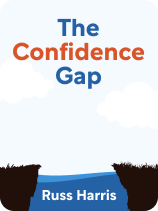

This article is an excerpt from the Shortform book guide to "The Confidence Gap" by Russ Harris. Shortform has the world's best summaries and analyses of books you should be reading.
Like this article? Sign up for a free trial here.
Want to know how to be more mindful and present? How can you practice this if you’re plagued by negative thoughts?
According to psychotherapist Russ Harris, you can’t get rid of the negative thoughts and feelings that distract you in everyday life—especially the feeling of fear. Harris stresses that learning how to be more present and mindful of your thoughts and fears requires continual practice.
Read on to learn how to be more mindful and present, despite negative thought patterns, based on Harris’s advice.
How to Be More Mindful and Present
In The Confidence Gap, psychotherapist Russ Harris provides an approach to dealing effectively with the negative, limiting thoughts and fears that prevent you from achieving your goals. Rather than trying to speak to, tamp down, or ignore negative thoughts—all ineffective methods—Harris recommends you relate differently to your thoughts by learning how to be more mindful and present. This will allow you to pursue your goals without your thoughts interfering with your efforts.
Harris is a trainer in Acceptance and Commitment Therapy (ACT) and has held workshops on this approach all over the world. He’s also authored several other books, including the best-selling The Happiness Trap. The Confidence Gap is for people who struggle to carry out their life goals and seek to change their thinking to be more empowering.
For Harris, being more mindful and present consists of paying attention to what’s happening in your mind and around you, being open to learning about what’s happening, being curious about how it’s happening, and flexibly adapting your attention to the situation by broadening or narrowing it, depending on what’s most helpful to you in the moment.
(Shortform note: Harris advocates being mindful and present primarily when pursuing goals. However, the Dalai Lama feels you should be present at all times (or at least as often as possible). This is because the ability to be present is the foundation for leading a spiritually fulfilled life, in which you act on spiritual teachings on a daily basis. For the Dalai Lama, being present consists of having a calm mind that lets you see clearly and without the filters of thoughts and feelings what is happening around you. In practice, this is similar to Harris’s definition of being present, except that Harris adds the step of adapting your attention based on what best serves you now. He likely has this step because he focuses on being present when pursuing a specific aim.)
Let’s see what being present might look like if you’re about to perform a stand-up set: First, you’d pay attention to the thoughts running through your head, how your body feels being on stage, and how the audience is reacting. Then, you’d be open to recognizing negative thoughts, noticing that your palms are sweaty and that the back row is disengaged.
You’d next be curious about why these things might be the case. You could note that your mind sends out negative thoughts when you’re performing and that perhaps the reason the back rows aren’t laughing is that you’re not loud enough. Finally, you’d adapt your attention to focus on what’s most likely to let you succeed on stage: You’d detach from the negative thoughts, stop thinking about the back rows, and simply focus on the laughing front row. When you later rehearse your set, you can act on your discovery that you might not be loud enough and practice projecting.
Being Present Requires Practice
As we’ve already seen, Harris believes that you must practice the cognitive skills we’re talking about to become better at them, and the skill of being present is no exception. You can practice being more present in two ways:
Perform breathing exercises. Harris recommends an exercise in which you first take 10 deep, intentional breaths and then breathe naturally, keeping your attention on the in- and outflow of the breath for as long as possible until you become distracted by a passing thought. When you notice this, just gently redirect your attention to the breath.
Perform mundane tasks mindfully. Practice being more mindful by paying close attention to what you’re doing—the motions you perform, the colors you see, smells, textures, and so on—as if you’ve never performed this activity before.
Harris notes that staying present will be difficult at first because the mind constantly serves up thoughts that draw your attention away from the present moment. When this happens, simply acknowledge that your attention has been drawn away and return it to the present without admonishing yourself.
| Bringing Greater Presence to Your Whole Life In these exercises, Harris draws on meditation and mindfulness practices. If you’re looking to not just pursue your goals more fully but also make better decisions and generally be more aware in life, you might consider making meditation and mindfulness a part of your daily routine. You can do this by, for instance, setting a daily meditation schedule. Consistent practice is key to strengthening your mind’s ability to be present. One neuroscientist discovered that meditating for only 12 minutes five times a week improves your ability to focus. You might therefore perform Harris’s breathing exercise every weekday morning before going to work. If you want a different flavor of meditation, you might consider a loving-kindness meditation or a body scan. These involve more steps than simply paying attention to your breathing. Further, to learn how to be even more mindful and present when performing mundane tasks, you might create mental shortcuts that associate actions or places with being present. For example, getting in the car in the morning triggers you to become present and focus on your motions. |
Practice Detachment for Mindfulness
To learn how to be more mindful of your thinking patterns, Harris says you can practice labeling a negative thought, so you can detach from it. To do this, first state the thought “out loud” in your mind. This might be: “I’ll fail at this anyway, so there’s no point in trying.” Then, visualize those words and mentally modify their appearance: You can change the font, size, color, or visualize them as graffiti, a label on food packaging, or as titles in a film.
(Shortform note: Visualizing words isn’t just useful for detaching from thoughts: It’s also used as a memorization device. In Moonwalking with Einstein, Joshua Foer recommends memorizing poetry by visualizing words, so you create a line of images. It’s easiest when you choose images of things that sound like or rhyme with the word. For instance, you could swap “here” for an image of an ear.)
If you’re not a visual person, you might “sing” the words in your mind (or out loud), suggests Harris. You can sing to the tune of “happy birthday” or your favorite song, or you can “hear” the words as a tinny radio voice or as an actor reading off a script. Alternatively, if you gave your thought a name in the last step, you might picture that individual or creature saying the thought. For example, the scaredy-cat might be a fretful cat who says: “There’s no use trying!”
When practicing being more mindful and present, feel free to come up with your own version of detaching that works best for you: Harris claims detaching is most effective when you devise a method that suits you.
(Shortform note: If you prefer “hearing” your thought in your head, it might mean you’re also an auditory learner. These are people who prefer receiving information by listening. If this is the case, you might also practice relating to your thoughts—in other words, going through the cycle of improvement we described above—by reviewing your practice out loud with a friend or therapist. This might help solidify your assessment of your progress and better inform how to modify your approach. An additional benefit of changing how you practice according to what type of learner you are is that you’ll improve more quickly: As Harris asserts, when you perform these mental exercises according to the method that suits you, they’ll be more effective.)
The result of detaching from thoughts is that they lose the power to dictate your actions, asserts Harris. They remain in your mind and never go away, but you can be more mindful of them and continue living your life in the way you want without acting on their input.
(Shortform note: It may seem impossible to not heed your thoughts when deciding how to act. After all, our only resource for decision-making is ultimately our brain and the thoughts it produces. While it’s true that we eventually must rely on our own faculties to make decisions, it’s also true, as Harris claims, that our thoughts often aren’t based in reality and thus aren’t always helpful in decision-making: Thoughts can be triggered by random occurrences (a memory, a phrase, an image, the environment) and have nothing to do with logical decision-making. For example, you might have the thought that you want a piece of apple pie simply because you saw someone eating that—not because eating pie is the logical next step for you to take today.)

———End of Preview———
Like what you just read? Read the rest of the world's best book summary and analysis of Russ Harris's "The Confidence Gap" at Shortform.
Here's what you'll find in our full The Confidence Gap summary:
- How negative, limiting thoughts and fears prevent you from achieving your goals
- Why trying to ignore negative thoughts doesn't work
- The three steps to detach yourself from your negative thoughts






